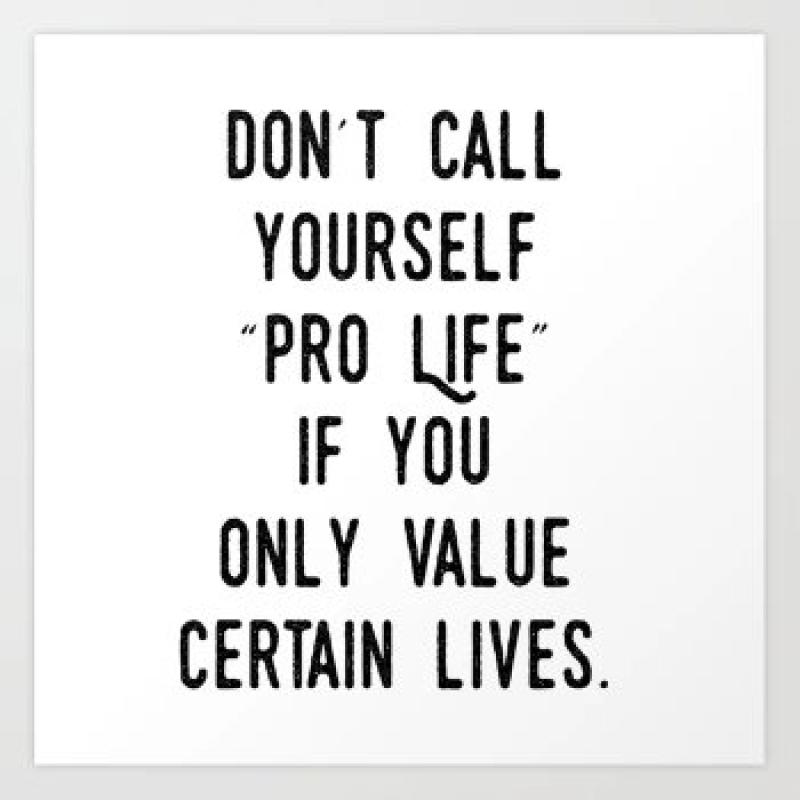A Pro-Life Case For Elizabeth Warren




Candidate B is formally pro-choice. He supports Roe and will work to protect and even extend abortion rights. As a liberal, he also supports an expanded social safety net, including universal healthcare; a higher minimum wage; paid family and medical leave; expanded government support for childcare, pre-K education, and nutritional assistance for women, infants, and children (WIC); and child and family tax credits.
Despite your pro-life convictions, you have been persuaded that Candidate A’s social policies would result in a minimal net reduction in the number of actual abortions that take place in the United States, and could well lead to a flattening or slight rise in demand. Conversely, you are now just as convinced that the social policies Candidate B favors, if enacted, would result in a reduction in the abortion rate.
So, I asked my friend, who would you vote for: the pro-life candidate whose policies are likely to maintain or increase the rate of abortion, or the candidate whose policies are likely to reduce it? His answer, which you may have already anticipated, was Candidate A. His rationale? Candidate A is the pro-life candidate because of his formal position on Roe v. Wade. Period. End of discussion. Along the way, my friend also challenged the assumption that there is any connection between the abortion rate and the social policies of presidential administrations.
And yet, the evidence of the past forty years argues the opposite. Under pro-life Ronald Reagan, the abortion rate remained static at 24 per 1,000 women. Under pro-life George H.W. Bush, it fell very slightly to 23 per 1,000 women, but under Bill Clinton, the rate tumbled dramatically, from 23 to 16.2. Then under pro-life George W. Bush, the rate mostly stayed constant, dropping to 15 at the end of his term. Under Obama it dove again to 11.8 in 2015, the last year for which I could find statistics.
To recap, in the 34 years between 1981 and 2015, the abortion rate dropped a total of 2.2 per 1,000 women during 20 years of pro-life presidencies and 10 per 1,000 women during 14 years of pro-choice presidencies. Put another way, whether intended or not the policies of pro-choice presidents were three and a half times as effective at reducing the abortion rate as pro-life presidents.
The reason why that is may likewise be drawn directly from the research . In the Guttmacher Institute’s 2005 study of 1208 post-abortive women, 73% said they sought the procedure due to economic concerns: unemployment or a single, insufficient income incapable of covering basic needs plus the added costs of baby and child care. Seventy-four percent also said that having a child would interfere with their ability to work or get an education, or would draw resources away from their other children.
If the Guttmacher study is accurate – and it is widely cited, including by pro-life organizations, as above – then the connection between the abortion rate and expansions and contractions of the social safety net is obvious. As John Medaille writes in his recent Front Porch Republic article , “A principled stance against abortion makes sense only within a matrix that ties together the economic and social ordering of society. Apart from a social order that welcomes children and an economic order that supports families, the prohibition of abortion appears to be just an arbitrary denominational stricture …”
Unfortunately, the 40-year alliance between the Republican Party and the formal pro-life movement has severed that matrix. The price the GOP has paid for becoming home to the pro-life movement is that it has alienated large swaths of the American electorate, both demographic and regional. But the price the pro-life movement has paid for the alliance has been much higher. In building its nest with the GOP, the pro-life movement has gradually come to accept the neoliberal ideology at the heart of that party, with its disdain for government and uncritical embrace of laissez-faire capitalism.
Social conservatives can’t say they weren’t warned. In a forgotten column published months before Ronald Reagan’s victory over Jimmy Carter, George Will wrote, “The Republican platform of 1980 stresses two themes that are not as harmonious as Republicans suppose. One is cultural conservatism. The other is capitalist dynamism. The latter dissolves the former. Capitalism undermines traditional social structures and values. Republicans see no connection between the cultural phenomena they deplore and the capitalist culture they promise to intensify.”
Worse than that, though, the alliance has unknowingly led many pro-lifers to view the unborn as a mere abstraction, a symbol in the broader war over culture. That’s why a good, intelligent, deeply faith-filled man like my friend – a man who has spent countless hours walking countless miles in protest outside abortion clinics – can blithely dismiss the evidence that an expanded social safety net saves unborn lives.
Well, I can’t dismiss the evidence because behind the statistics loom the concrete, flesh and blood lives of unborn human beings. So before I continue, let me declare myself. I believe that human life begins at conception. As a consequence, I believe that abortion is the intentional destruction of an innocent human life. Though I am a Catholic, that conclusion isn’t necessarily religious. It doesn’t depend on Scripture, the Creed, or the Deposit of Faith. It rests on the simple logic of nature, backed by the clear evidence of science. A conceptus at any stage – zygote, blastocyst, embryo, and fetus – is a unique individual with a DNA signature different from its mother, which is how we moderns differentiate one human being from another . I leave the question of personhood to the metaphysicians: I have never met a human being who was not a human person, or vice versa, so for me the distinction is irrelevant. Abortion is killing.
Would I support overturning Roe v. Wade? Yes. Not only was it bad constitutional jurisprudence, a conclusion even many pro-choice legal minds agree on, but it removed the issue of abortion from the democratic process, which only hardened both sides in their silos. If Roe were overturned, would I advocate that my state pass laws to outlaw abortion? I would, but only within the matrix of “a social order that welcomes children and an economic order that supports families,” in John Medaille’s words.
And what would that matrix look like? For my money, it would look a lot like Elizabeth Warren’s presidential platform.
Warren, the senior senator from Massachusetts, is nothing if not consistent. Formerly a law professor at the University of Houston, UPenn, and Harvard, over 25 years Warren has become the scourge of corporate interests, especially in the financial sector. The stated goal of her presidential run is to level the economic playing field and rebuild the middle class. Her policy prescriptions have been detailed, wide-ranging, and internally consistent: use the power of government to make life easier for middle and lower class families. In addition to strengthening existing social safety net programs like WIC (nutritional assistance for women, infants, and children), TANF (Temporary Aid to Needy Families), and SNAP (also known as “food stamps”), Warren has proposed the following:
Healthcare : Make it universally available through Medicare for all.
Childcare : Make it universally available at no cost for families at 200% of the federal poverty level and below, and on a sliding scale up to 7% of income for families that make more.
College : No tuition for public colleges and universities, and elimination of $640 billion in education debt, which would encompass about 75% of the 45 million education loan borrowers in the United States.
Paid family leave : Warren has signed on to the Family and Medical Leave Act, which would provide 12 weeks of paid family – not just parental – leave at 66% of monthly wages.
Housing : Make a $500 billion investment over ten years focused on the rehabilitation and construction of new affordable housing. By adding new units to tight markets, the cost of rent could be expected to drop by 10%.
Wages : Warren favors dramatically increasing the federal minimum wage, now a ridiculous $7.25 an hour.
Since the tilted playing field is largely the creation of corrupt Washington insiders – what someone else called “The Swamp” – Warren has also proposed The Anti-Corruption and Public Integrity Act , a set of radical measures that would transform the way Washington does business and on whose behalf. Elected representatives would be barred for life from becoming lobbyists after their time in office, and would be forbidden to trade in stocks during their terms. She would close the revolving door that leads to regulatory capture by ending the practice of lobbyists moving in and out of government jobs. Policy makers would be incentivized to put the interests of the American people, and especially the poor and the middle class, ahead of their own interests or those of their corporate patrons.
And Warren is putting her money where her mouth is. She’s not accepting any donations from PACs or lobbyists. She’s holding no big money fundraisers. She’s in favor of overturning Citizens United, the Supreme Court decision that essentially eviscerated campaign finance reform. She supports public financing of congressional elections and expanded federal funding of presidential elections. She opposes “self-funding.”
I can hear the howling now: But Warren is in favor of nearly unlimited abortion rights! Her position is directly opposed to the teaching of the Church. She would eliminate the Hyde Amendment and the Mexico City Policy! I agree with all of that, and I disagree vehemently with Warren on abortion. Therefore, my vote will be cast in spite of, not because of, her position, which I consider extreme and immoral. But I’ll still cast it, and gladly so, because I believe that whether she intends it or not lives would be saved under a Warren Administration.
More howling! But how can any Catholic vote for a pro-choice politician? In fact, there is no blanket requirement for Catholic voters to vote against a pro-choice politician, even when that politician is competing against someone who is formally pro-life. Church teaching on this point was succinctly summarized in 2004 by Pope Benedict XVI, then the head of the Congregation for the Doctrine of the Faith, who wrote, “A Catholic would be guilty of formal cooperation in evil, and so unworthy to present himself for Holy Communion, if he were to deliberately vote for a candidate precisely because of the candidate’s permissive stand on abortion and/or euthanasia. When a Catholic does not share a candidate’s stand in favor of abortion and/or euthanasia but votes for that candidate for other reasons, it is considered remote material cooperation, which can be permitted in the presence of proportionate reasons.”
So, I’ve just written that I disagree with Warren’s position on abortion and will vote for her in spite of it. What remains is for me to demonstrate the presence of “proportionate reasons” for doing so. Here they are: Based on all available information, I’m convinced that a Warren presidency would have a greater positive effect on the abortion rate than any other candidate, especially Donald Trump, whose commitment to shredding the social safety net seems unlimited. A nation that reflected Warren’s platform would be one in which the matrix of “a social order that welcomes children and an economic order that supports families” would be more fully realized and that matrix would provide women with greater incentives to reject abortion and bring their pregnancies to term. In concrete terms, this could mean tens of thousands of unborn children surviving pregnancy. Those are real human beings – not symbols in the culture war – who might live rather than die.
In 2015, the latest year for which I could find statistics, there were 638,000 abortions in the United States , down from a high of 1.4 million in 1990. As we’ve seen, the abortion rate – defined as the number of abortions per 1,000 women – falls more rapidly under Democratic presidents with a commitment to the social safety net than it does under Republicans: from 23 to 16.2 under Clinton and from 15 to 11.8 under Obama. But neither Clinton nor Obama proposed social policies anywhere near as robust as Warren’s. Her proposals are a literal game-changer, and would align the United States much more closely with the social democratic nations of Europe, the largest of which is Germany.
The German abortion rate in 2015 was 5.5 abortions per 1,000 women . If the American abortion rate in 2015 had been 5.5 rather than 11.8, it would have meant 341,000 fewer abortions that year alone. I don’t think it’s a coincidence that Germany has multiple, overlapping supports for pregnant women and families, including universal healthcare, generous maternity and family leave, no-cost public colleges, and higher wages. If a Warren Administration was able to preserve and extend our current safety net, and add universal healthcare, childcare, and generous paid family leave to it, I believe it would save tens of thousands, if not hundreds of thousands, of unborn lives. Those are my proportionate reasons.
But that’s not good enough for some in the pro-life movement. They have one strategy only: capture the Supreme Court and overturn Roe v. Wade. Their pretense, the lie that keeps money flowing into the coffers of pro-life organizations, is that doing so would outlaw abortion. Here’s the fact: there will be no Human Life Amendment to the US Constitution because the votes aren’t there and never will be, and overturning Roe would just return the issue to the states. Abortion would still be legal in over half the states, an easy flight or drive for most wealthy and middle class women. Yes, a poor woman in Mississippi might not be able to get a legal abortion, but you can be sure that the black market for abortions would flourish. It always has. It always will.
How much better it would be if the pro-life movement would invest in strengthening a “a social order that welcomes children and an economic order that supports families?” How much more truly pro-life it would be if Catholics rejected once and for all the idolatry of the market at the heart of the modern GOP, a cult that sacrifices families, the poor, the stranger, the sick, the elderly, and yes, the unborn.
A final word about proportionate reasons. In 2008, Archbishop Charles Chaput asked, “What is a ‘proportionate’ reason when it comes to the abortion issue? It’s the kind of reason we will be able to explain, with a clean heart, to the victims of abortion when we meet them face to face in the next life – which we most certainly will. If we’re confident that these victims will accept our motives as something more than an alibi, then we can proceed.” I would say a similar test is what we would say to living persons who avoided becoming victims of abortion because of our commitment to create the conditions in which their mothers were better able to choose life over death.
Tags




